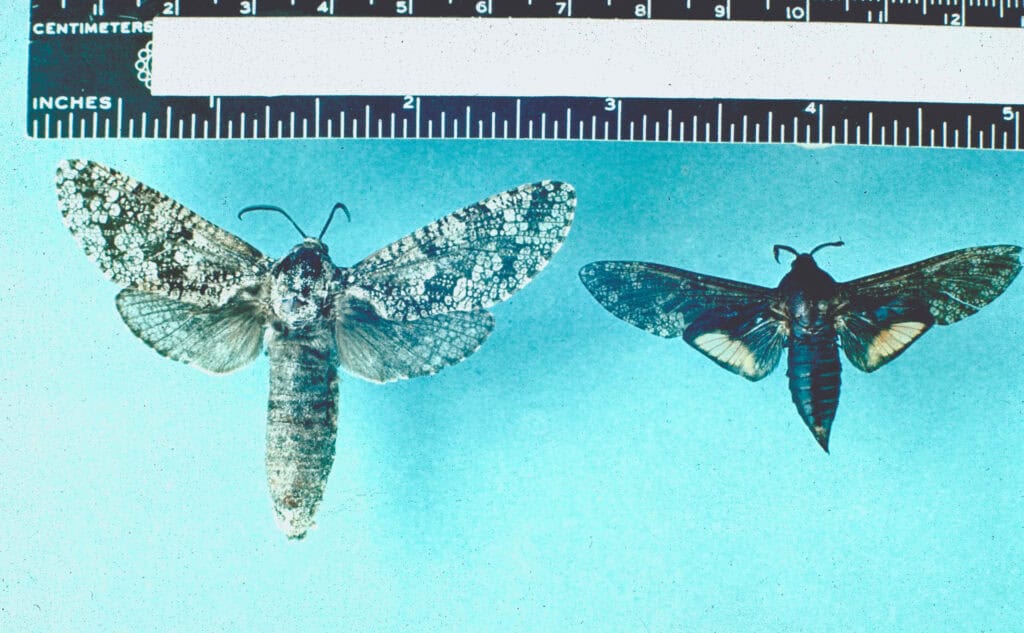Native Moth

The male carpenterworm moth is considerably smaller than the female. Photo: James Solomon, USDA
On our morning walk my husband discovered a moth on the roadway. It was magnificently camouflaged on the worn blacktop, which now has a gray stony look from over 50 years of wear since it was last resurfaced. The cryptic gray moth blended right into the road’s surface. After he pointed it out I suggested it looked like a member of the sphinx family.

The carpenterworm is so cryptic that it is rather well camouflaged on any background. Photo: J. Morton Galetto
Upon closer inspection I identified it as a Prionoxystus robiniae, whose common names include Robin’s carpenterworm, carpenter borer, or locust borer, because its larva is a wood borer. And indeed it is often mistaken for a sphinx moth. In its larval stage it can take one to four years to reach maturity and for the duration of that time it is tunneling in trees. Although it is a native species, for the lumber industry it is generally considered a pest species.
The species range is from across southern Canada throughout much of the continental United States. The larva’s preferred wood is deciduous trees, such as locust, oak, chestnut, poplar, willow, maple, and ash. In southern climes the species may mature from larva to moth in a year’s time. In more northern regions the species matures in three to four years.
The carpenterworm Prionoxystus robiniae is a member of the Cossidae family that contains more than 110 genera with almost 700 species. One of the most famous members of the family is gusanos de maguey, Spanish for agave worms, found in mezcal. Tequila is a type of mezcal but not all mezcal is tequila. The distiller Del Maguey explains, “Mezcal is a broader category of spirits distilled from agave, while tequila is a specific type of mezcal made only from blue agave in certain designated regions of Mexico.”
True tequila is only supposed to derive from the Mexican village of Tequila, similar to Champagne only being of French origin (the rest sparkling wine), I suppose.
Now tequila is controlled in Mexico and not allowed to have the gusanos in the bottle. In 2022 Akito Kawahara, curator at the Florida Museum’s McGuire Center for Lepidoptera and Biodiversity, decided to positively identify the “worm” found in the bottom of mezcal. Using the DNA from alcohol preserved gusanos de maguey they determined the species to be Comadia redtenbacheri or agave redworm moth—a not so sober relative to the one found on our morning walk.
The redworm is said to add a flavor dimension to the spirits. I can’t attest to that, but it surely adds a marketing angle. Lore dictates that a live worm was added to a bottle and if it wiggled to the bottom the distillation process had been safely achieved. By the way, it doesn’t wiggle for long.
Let’s return to our local Robin’s carpenterworm. The female we found, like its comrades, has a wingspan of more than three inches. The male counterpart is smaller. Adults emerge between May and August, from trees in which their larvae are bored. The adult female moth will lay 200-1,000 eggs on the bark of host trees.


TOP: The carpenterworm moth’s larva is a borer. The caterpillar lives in a tree’s interior for one to four years before metamorphizing into a moth. ABOVE: Although the lumber industry considers the carpenterworm a pest, sometimes the borings are used as a decorative detail, as found in wormwood paneling. PhotoS: James Solomon, USDA
The young larvae will bore into the bark layer and as they mature they will seek the heartwood. Tunnels to the outside are enlarged as the larva matures. Eventually the tunnel is lined with silk and the pupation takes place. Pupae wiggle to the entrance where the adult emerges and the pupal case is left behind. The female gives off pheromones and is found by a male; they mate, she lays eggs, and then the entire cycle repeats itself.
Tunnels in the wood are a nuisance if trees are intended for lumber, but the carpenterworms seldom kill trees. However, limbs can be compromised and are more likely to break off in strong winds. Their holes also offer entrances for infestation by other pests.
A Photographic Guide to Forest Pest Insects in North America: A Photographic Guide offers greater geographic specificity to infestations; “In the southern United States, oaks (Quercus), particularly members of the red oak group, are heavily damaged. In the prairies and Rocky Mountains of North America, poplar species (Populus) and green ash (Fraxinus pennsylvanica Marshall) are major hosts. In California, live oak (Quercus agrifolia Née) and introduced elms (Ulmus) are hosts. Other hosts include black locust (Robinia pseudoacacia L.), maple (Acer), and willow (Salix), among others.”
The carpenterworm has its connections to the ecosystem. The holes it bores play a role in the start of cavity-nesting bird’s burrows. The hooked tongues of woodpeckers are able to extract the larva from holes for food. Adult moths of the carpenterworm are eaten by big brown bats in New Jersey. Big brown bats and their allies also eat a host of other insect pests in the state.

Log has been split lengthwise to enable the path of a Robin’s carpenterworm to be viewed. Photo: Bob Hammon, Colorado State University
Rutgers Extension has a great article on the economic importance of bats in integrated pest management. They point out that after decades of increased pesticide use that at least 400 agricultural pests have evolved to have a degree of tolerance to pesticide products—pesticides that often compromise human health. Often, biological control agents are utilized, many which are non-native and can have long-lasting negative ramifications—for example, Chinese mantis, cane toads or mongoose.
But insectivorous native bats serve as natural biological control. Rutgers New Jersey Agricultural Experiment Station elaborates: “…bats are highly effective generalist predators, and studies have documented the presence of many agricultural pest species in their diet. Especially during the summer months, when bats are raising young, female bats consume a significant proportion of their body weight in insects per day. Because they feed within a few kilometers of their roost site and return to the same roost every day, bats may play an important role in local suppression of agricultural insect pests.”

Robin’s carpenterworm damage on the trunk of a tree. Photo: James Solomon, USDA
Since bats eat a host of other agricultural insects, possibly the food source of carpenterworms adult moths allow them to devour other more bothersome pests. Carpenterworms also play a role in the success of nesting birds. The web of life has many dependencies that are so intricate it is hard to know how easily its balance can be tilted toward extinction, with the loss of a species. It is challenging at times to appreciate all living things, but we must strive to do so.
Today’s story has taken us down a worm hole of information beginning with a moth, infested trees, a bottle of mezcal, woodpeckers, and some hungry bats. We need to be open to the possibilities that life’s creatures great and small all play a role in the health of the planet. I have a lot of strides to make in this regard. Take ticks, greenheads and mosquitoes, for example. I’m just not ready to write them thank-you notes. But we must recognize all life has a role on this orb we share—our planet.
Sources
Scientists uncover the unexpected identity of mezcal worms, by Jerald Pinson, March 8, 2023 Florida Museum, University of Florida, www.floridamuseum.ufl.edu.
DelMaguey.com, “Mezcal with a Worm: Why?” Carlos Andrés Ramírez, January 10, 2024.
Rutgers.edu. “Ecological and Economic Importance of Bats in Integrated Pest Management,” Brooke Maslo, Extension Specialist, Wildlife Ecology, Kathleen Kerwin, Coordinator, Department of Ecology, Evolution, and Natural Resources.
Discovering Moths, Nighttime Jewels in Your Own Backyard, John Himmelman, 2002, Down East Books.
Forest Pest Insects in North America: A Photographic Guide, Roy G. Van Driesche, Joseph H. LaForest, Charles T. Bargeron, and Richard C. Reardon. University of Massachusetts, US Forest Service, Center for Invasive Species, and University of Georgia, pg. 431- 436.
Special thanks: Center for Invasive Species and Ecosystem Health, University of Georgia, Bugwood Images forestry archive.








